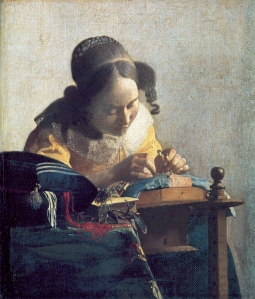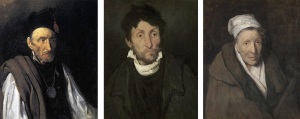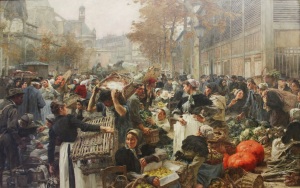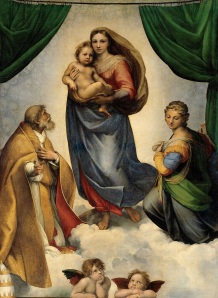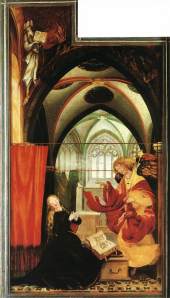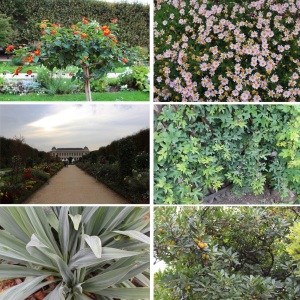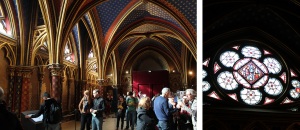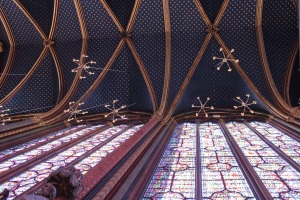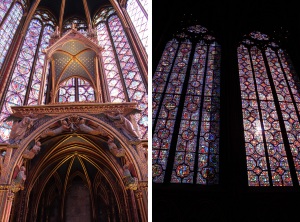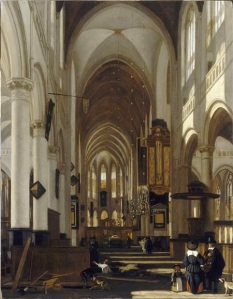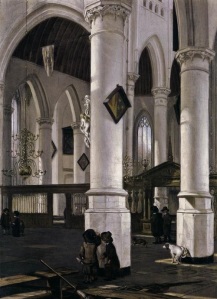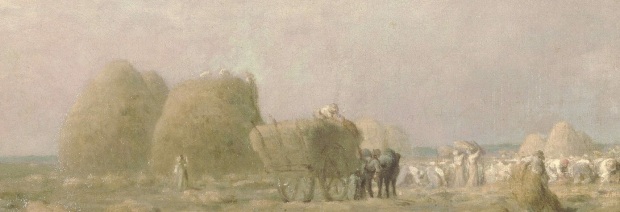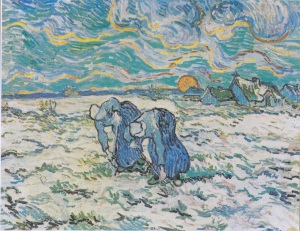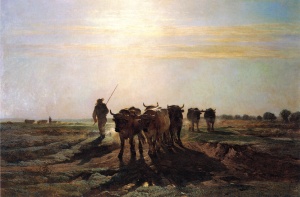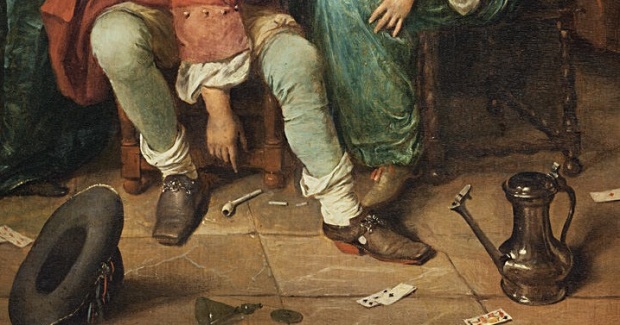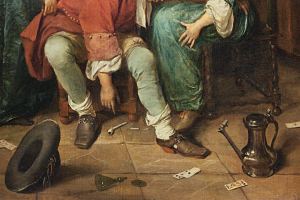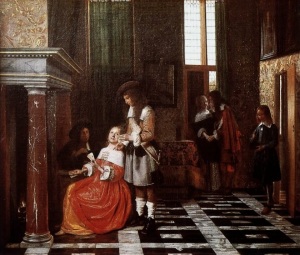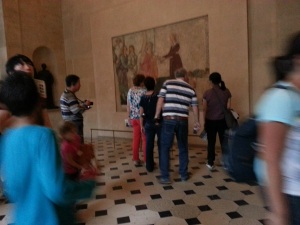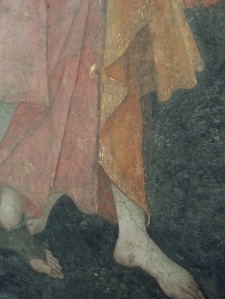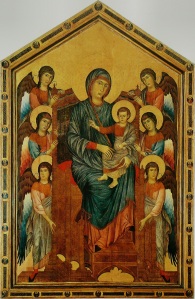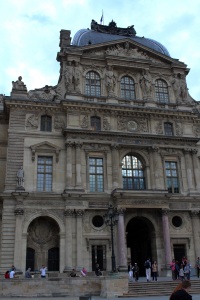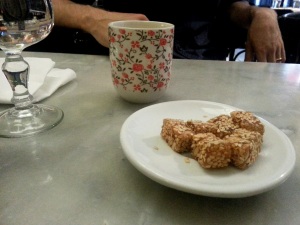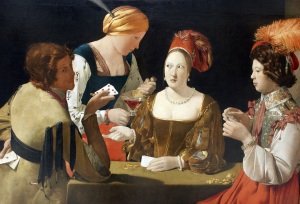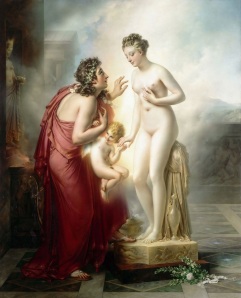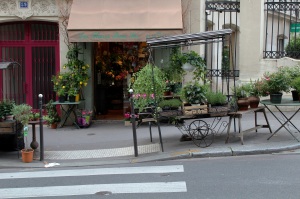I recently got a chance to spend some time with what might be my favourite painting of all time, View of Delft (Vermeer), 1661. The painting portrays the artist’s hometown, surprisingly much larger than anticipated but complete with every glimmering ripple in the water and every rouge brick expertly painted, and the ever present rolling billowy clouds swathing quarters of the town in shade. In 1661 cityscapes were not a popular scene, paintings of the time usually favoured interior Dutch Genre scenes, so the rareness of such a painting is a gem in itself. What’s amazing about Vermeer is his ability to render scenes in exquisite detail. There are plenty of Dutch contemporaries who have created many fine works of similar quality, but there is something special about Vermeer. There is something that sets him apart from the others, some special relatable quality of his works which pluck at our heart strings.
There is hot debate about how Vermeer came to be so amazing, and the amount of evidence and speculation have lead the art community to take choose camps to support and usually battle each other quite viciously. The debate surrounds the notion of Vermeer using visual aids, but frankly the debate comes down to the idea of genius. There is this romantic idea that artists have some special talent that is imbued in them like a magic spell, which gives them superpowers that allow them to create great masterpieces which the general rabble couldn’t achieve, and some argue, can’t even comprehend.
You wouldn’t understand, you are not an artist.
To suggest that an artist used a device which greatly aided their task tarnishes the illusion that artists have god-given specialness and therefore diminishes the value of the work. Where do we draw the line for what tools are acceptable? Many artists use a grid and rulers to plan their work, to keep it in line with their source material and notions of perspective. If two artists paint nice pictures and one uses a grid to plan their composition, is one really more impressive than the other? What if we aren’t aware which artist used the grid.. does it really matter? Those who believe that aids were used “argued that naysayer art historians dreaded the use of mechanical device, because it would diminish the stature of the artist’s as a creator and, perhaps, a bit of the prestige of the art historians themselves, key negotiators between the artist and the public” 1.
The argument of what makes art “art” is very long and convoluted but it is generally agreed that if a work is visually interesting or represents and interesting idea then it has value. Paintings which we can easily relate to the subject and appreciate its accuracy to our reality is a primary basis for judgement, and one that is particularly comforting. The admiration for accurate depictions of reality is long-standing and historically considered to be essential criteria for measuring an artists’ or works’ worth. Vermeer’s drive for visual realism, coupled with his love for ordinary Dutch society allows for a very honest and dedicated civilian cross section. Among his contemporaries you will find a great number of commissioned portraits of merchants or gentlemanly societies, interior scenes with exaggerated debauchery and similar fodder for moral undertones. Vermeer is no stranger to moral undertones yet his are more of a whisper than being knocked over the head with it. His scenes usually depict idyllic domesticity, the sheer timeless perfection of it enough to drive a person to desire the good life. His subjects are painted in utter perfection, in fact so much so that we are lead to believe that Vermeer is either a genius or a cheat to achieve such an accomplishment, and so the speculation begins.
One example of Vermeer’s style which suggests the use of aids is the extreme perspective accuracy. Vermeer “could have observed and even been stimulated to sketch the more brightly illuminated images produced at a smaller scale by a portable camera obscura [… however] he could have produced them by using graphical methods taught by his fellow countrymen De Vries and Hondius in conjunction with a well-known technique which made use of a pin inserted at the vanishing point with a thread attached to it and held taut to define the orthogonals of the scene” 2. Using grids and rules to better understand the principles of geometry and perspective is not a secret. Many attempts were made to understand spacial order in Medieval times, ultimately culminating in the understanding of linear perspective developed in the Renaissance. Regardless, for Vermeer, there is considerable evidence that he specifically used optical devices as aids to create paintings. There is, however, no historical or archival data to confirm this notion, including the fact that the detailed inventory of the artist’s belongings drawn up after his death does not include a camera obscura or any similar device 3.
The Lacemaker, (Vermeer)1670
Instead, scholars and critics look to the paintings themselves to glean bit of evidence of optical illusions rendered into the work. For example, Daniel Fink built a camera obscura in 1971 to observe objects similar to those found in Vermeer paintings, and observed them in the same conditions that the artist would have as confirmed with historical data. Fink believes there are optical elements directly resulting from a camera obscura in most of Vermeer’s works including but not limited to ; “variations [of]principal planes of focus, halation of highlights, relative detail in still life portion versus figure detail, consistent proportions of the paintings (4-5:5 or almost square), [and] dimensional precision in rendering objects” 4. My research into the optical illusion debate contains many references to the Lacemaker (Vermeer), 1670, so I took a quick trip down to the Louvre to investigate this work a little closer.
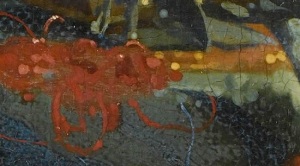
extreme close up!! whoaaaaa!
It is suggested that the unfocused areas of the work are the direct result of lens and/or camera intervention. Furthermore, “maximum highlights glimmer with the so called disks of confusion, or pointillés as they are sometimes called when they are translated into paint. Pointillés, a conspicuous feature of many of Vermeer’s paintings, cannot be perceived with the naked eye and do not seem likely stylistic invention. The are, however, produced by the camera obscura’s imperfect lens” 5. Indeed, many aspects of the Lacemaker are almost abstractly blurred, fuzzy blobs of paint akin to the type of pointillés and diffusion known to us now in the photographic era. Though the use of lenses in the exploration of telescopes and cameras was not unknown to Vermeer at the time, the notion that Vermeer chose to paint certain areas out of focus and certain areas very focused does not prove the usage of cameras and lenses as aids. The Louvre’s blurb on the work suggests that it was Vermeer’s genius to paint certain areas in and out of focus to mimic binocular (vision) to provide a livelier portrayal, “reproducing the natural optical deformations of the human eye by creating several depths of field […] the lacemaker’s painstaking work, is shown in great detail and in sharp focus, particularly the fine white thread stretched between the young woman’s fingers. Further away from this visual focus, the forms become more blurred, including, paradoxically, those in the foreground” 6. The use of curved lenses leads us to believe that the choice to have the subject in focus and the fore and back grounds unfocused was simply the work of the device and Vermeer no more than a a simple scribe transferring the information provided into paint. Ie. diminishing the notion of the artistic genius.
Similar techniques are employed in the View of Delft; “the pointillist technique that Vermeer used to suggest reflections flickering off the water, most easily visible on the two herring boats on the right, is evidence that he probably used a camera obscura to help compose the picture; diffused highlights such as these would appear when a partially focused image was obtained from this device” 7. It is not beyond the realm of possibility that Vermeer used such device as an aid but it is dangerous when you begin to assume that the use of such device negates all artistic intention. One issue with a camera obscura is that it is obtained by a pin-hole of light entering a darkened room. Read: darkened room. It is very presumptuous to believe, as is presented in the acclaimed film “Tim’s Vermeer” that any old person is able to render what Vermeer did with nothing more than a lens and paintbrush.
View of Delft (Vermeer), 1661, Detail
It is also suggested that Vermeer used an inverted Galilean telescope to create View of Delft. There are peculiarities of the painting which it has been suggested are optical effects that are a direct result of this device, which “condensed the panoramic view of Delft, diminished figures to smaller magnifications than normal and emphasized the foreground” 8. Here there exists a paradox. The painting itself is very detailed and expertly rendered, and if you believe he used optical devices the artist was slave to the conformations of optical devices and had no intention to compose the scene in any intelligent, artistic or creative way. However “in a topographical drawing by Abraham Rademeker (1675-1735), executed about half a century later from a similar vantage point, it is noticeable that the buildings appear taller and crammed closer together than in Vermeer’s picture. Vermeer seems to have shifted the buildings slightly to produce a more harmonious composition” 9.
At what point does the artist’s creative genius work in tandem with rendering tools? At what point does the tool make more aesthetic decisions than the artist? The are all questions we find ourselves asking in a more modern era, considering the advent of multiples and auto-creation. Is photography art? Does the artist’s intention, composition and execution of a photograph enough to consider it as meaningful as a painting? Does the camera itself take away from the magic of art-making? Does polaroid take more share in the credit for a famous photograph because it makes certain aesthetic choices for the artist? Warhol explored and challenged the notion of uniqueness and authenticity by developing a factory of artists churning out silkscreens. At what point does a Warhol stop being a Warhol? At what point does the artist’s vision for the finished work get interrupted by the technological aspects of its creation?
Halation. Source : Jonathan Janson
Andy Warhol’s 1964 “Red Self Portrait” was deemed not genuine by Andy Warhol Foundation for the Visual Arts, even though it was signed and dated in Warhol’s handwriting, and was included in the catalogues of his oeuvre published during his lifetime. Warhol had taken a self portrait in a photobooth, transferred it to silkscreen, delivered it to commercial printers with explicit instruction as to the creation and end result and had them do the work. The simple fact that he was not physically present during the final stage of its creation deems it not genuine by governing authority. The board’s lawyer himself admits “it has to do with the intent of the artist… if Warhol conceived the idea and he then directed someone else to prepare a silkscreen, and he then supervised the process of production and in effect signed off on it, whether or not he signed his name to it, as long as he said, “That’s good, that’s what I wanted,” Warhol created that work”10.
Despite the distortions evident in Vermeer’s work, whether or not they were inspired by the illusions of optical devices, there are a number of reasons to give credit to Vermeer as an artist of creative and brilliant foresight. The pleasing composition of the city scene contains both accurate depictions of Delft at that time and invented pictorial division. It has been noted that Vermeer intentionally spaced out the buildings to give both literal and interpreted pause and rest between them, despite accusations that an inverted telescope in fact would have condensed the scene. As I believe it is the artist’s aesthetic intent which creates a photograph rather than simple film processing, Vermeer chose the view to portray, as an artist decides when and how to point their camera. “A.K. Wheelock, who originally enthusiastically embraced the camera obscura-Vermeer tie, has backtracked and now holds that Vermeer “must have admired certain effects of color, light, and focus in a camera obscura, but that he persistently departed from what he actually saw in the camera, in his studio, or in another artist’s work in accord with his own highly refined aesthetic and expressive goals” 11. Vermeer’s choice of scale and cropping ends up with a balanced composition hinting the viewer as to the nature of the city itself.
Halation con’t. Girl with the Red Hat (Vermeer), 1666
Vermeer worked slowly, producing considerably few finished works during his lifetime. His style is meticulously detailed, the treatment of light especially pragmatic and the careful and loving depiction of simple objects elevates the banal to celebrated heights. “The meticulous way that Vermeer worked on this masterpiece is shown by the fact that he mixed grains of sand into some of his paint to achieve a certain texture. An examination of the picture has revealed that the sand was added to the ochre used on the window frames of the long building to the left, behind the ramparts, giving a greater reflective quality to the paint surface” 12. Vermeer’s choice to portray the scene in such a way as to allude to the pleasant and upstanding interpretation of Delft is also evident in the composition of the lighting. The majority of the scene, as is common with other Dutch paintings, is sky. The aesthetic of having compositions predominantly sky reflects not only the pragmatic and protestant Dutch lifestyle but also practical aspect of lowland painting, such as the low areas of land excluding large changes or areas of visual interest, combined with the ever present billowing clouds typical of the region and unequalled Dutch light, said to have a unique quality. “Historically, the Dutch maintained a unique and tangible relationship with their land, quoting a popular Dutch saying: ‘God created the world, but the Dutch created Holland’ 13. The large dark clouds swarm the top of the scene, giving the viewer respite from the bright light of the sun. The immediate areas of town are shaded yet clear and rich in colour, perfectly crafted. The congestion of the town as is recedes into the background stunningly highlighted by the sun’s break from the clouds, brilliantly illuminating the New Church. Vermeer aspired to portray “View of Delft reflects Vermeer’s concept of beauty and the prominent churches could be a subtle reinforcement of Christian morals and values of this time. It could also be that by painting the Old Church in shadow and the New Church in sunlight that he was portraying the city’s spiritual growth” 14.
Source : http://arthistory.we-wish.net/2008/11/24/highlights-of-paris/
The more scientific explorations of Vermeer’s secrets comes up with more and more complicated conspiracy theories. There are undeniable peculiarities in Vermeer’s work which correspond with effects from optical devices that would have been available to him at the time, though there is no evidence to prove he ever owned any. Even if he did, so what? Even if he looked at his subject through a lens or a telescope, passing the light through lenses to be able to see the subject’s detail more closely and to be better able to passionately dedicate this information to paint. Vermeer made around three paintings a year, dying in young poverty and relatively unknown outside Delft. We still know that he employed the most expensive pigments at a far greater quantity than his contemporaries, spending such exorbitant amounts of time on each painting making any kind of decent wage is outside the realm of possibility. His dedication, however, is key to his genius. If Vermeer used optics, well so what. It may have been another tool in his toolkit, another instrument to employ in his endeavor for, and ultimately his success in perfection.
1, 2, 3, 4, 5, 11 http://www.essentialvermeer.com/camera_obscura/co_one.html
6 http://www.louvre.fr/en/oeuvre-notices/lacemaker
7, 9, 12 Bailey, Matin. Vermeer. London : Phaidon Inc., 1995.
8 Ferguson, Rex. Criminal Law and the Modernist Novel : Experience on Trial. New York : Cambridge University Press, 2013.
13 Gold, John R, George Revill. Representing the Environment. London : Routledge, 2004.
14 http://www.artble.com/artists/johannes_vermeer/paintings/view_of_delft


